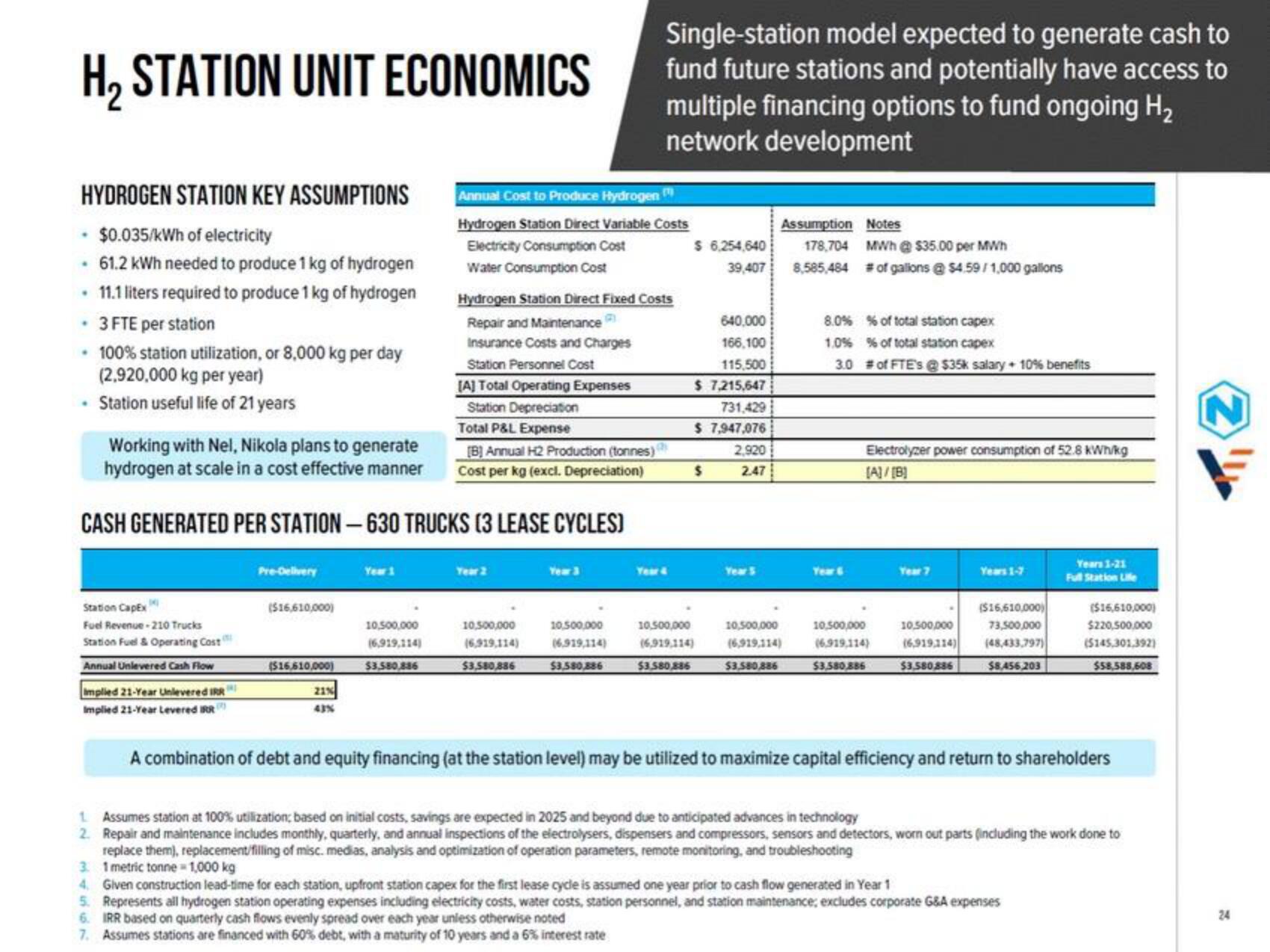Nikola SPAC Presentation Deck
H₂ STATION UNIT ECONOMICS
HYDROGEN STATION KEY ASSUMPTIONS
$0.035/kWh of electricity
• 61.2 kWh needed to produce 1 kg of hydrogen
• 11.1 liters required to produce 1 kg of hydrogen
• 3 FTE per station
• 100% station utilization, or 8,000 kg per day
(2,920,000 kg per year)
• Station useful life of 21 years
.
Station CapEx
Fuel Revenue-210 Trucks
Station Fuel & Operating Cost
Annual Unlevered Cash Flow
Hydrogen Station Direct Fixed Costs
Repair and Maintenance
Insurance Costs and Charges
Station Personnel Cost
[A] Total Operating Expenses
Station Depreciation
Total P&L Expense
Working with Nel, Nikola plans to generate
hydrogen at scale in a cost effective manner
[B] Annual H2 Production (tonnes)
Cost per kg (excl. Depreciation)
CASH GENERATED PER STATION-630 TRUCKS (3 LEASE CYCLES)
implied 21-Year Unlevered IRR
Implied 21-Year Levered IRR
Pre-Delivery
($16,610,000)
(516,610,000)
21%
43%
Year 1
10,500,000
(6,919,114)
$3,580,886
Annual Cost to Produce Hydrogen
Hydrogen Station Direct Variable Costs
Electricity Consumption Cost
Water Consumption Cost
Year 2
10,500,000
(6,919,114)
$3,580,886
Single-station model expected to generate cash to
fund future stations and potentially have access to
multiple financing options to fund ongoing H₂
network development
Year 3
10,500,000
(6,919,114)
$3,580,886
Year 4
$ 6,254,640
39,407
640,000
166,100
115,500
$ 7,215,647
731,429
$ 7,947,076
$
10,500,000
(6,919,114)
$3,580,886
2,920
2.47
Year 5
Assumption Notes
10,500,000
(6,919,114)
$3,580,886
178,704 MWh @ $35.00 per MWh
8,585,484 # of galions@ $4.59/1,000 gallons
8.0% % of total station capex
1.0% % of total station capex
3.0 # of FTE's @ $35k salary + 10% benefits
Year 6
Electrolyzer power consumption of 52.8 kWh/kg
[A]/[B]
10,500,000
(6,919,114)
$3,580,886
Year
Years 1-7
($16,610,000)
10,500,000 73,500,000
(6,919,114) (48,433,797)
$8,456,203
$3,580,886
Years 1-21
Full Station Life
($16,610,000)
$220,500,000
($145,301,392)
$58,588,608
A combination of debt and equity financing (at the station level) may be utilized to maximize capital efficiency and return to shareholders
1 Assumes station at 100% utilization; based on initial costs, savings are expected in 2025 and beyond due to anticipated advances in technology
2.
Repair and maintenance includes monthly, quarterly, and annual inspections of the electrolysers, dispensers and compressors, sensors and detectors, worn out parts (including the work done to
replace them), replacement filling of misc. medias, analysis and optimization of operation parameters, remote monitoring, and troubleshooting
3 1 metric tonne-1,000 kg
4. Given construction lead-time for each station, upfront station capex for the first lease cycle is assumed one year prior to cash flow generated in Year 1
5. Represents all hydrogen station operating expenses including electricity costs, water costs, station personnel, and station maintenance, excludes corporate G&A expenses
6. IRR based on quarterly cash flows evenly spread over each year unless otherwise noted
7. Assumes stations are financed with 60% debt, with a maturity of 10 years and a 6% interest rate
24View entire presentation